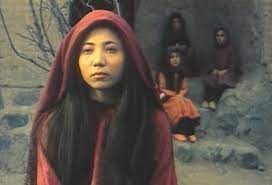Introduction:
“Daughters of the Sun,” a 2000 Iranian drama directed by Maryam Shahriar, emerges as a cinematic masterpiece that transcends its narrative boundaries to become a profound exploration of humanity, resilience, and the enduring spirit of women. In this extensive review, we embark on a journey through the thematic richness, directorial brilliance, and cultural significance that define “Daughters of the Sun.”
I. Cultural and Historical Context:
- The Iranian Landscape:
- Set against the backdrop of the Iranian landscape, “Daughters of the Sun” immerses viewers in the cultural and historical context of rural Iran. The film offers a glimpse into the lives of women in a traditional society, grappling with the challenges of their environment.
- Women in Iranian Cinema:
- The film contributes to the broader narrative of women in Iranian cinema, addressing themes of empowerment, resilience, and the complexities of their roles in a society undergoing transformation.
II. Plot Overview:
- Female Empowerment:
- “Daughters of the Sun” revolves around the lives of four Kurdish women who, faced with the harsh realities of their environment, take on unconventional roles to sustain their families. The narrative unfolds as a testament to their strength, highlighting their struggles and triumphs.
- Rural Realities:
- The film provides a window into the daily lives of these women as they navigate challenges such as poverty, patriarchy, and the aftermath of war. Each character’s journey becomes a microcosm of the larger societal changes shaping Iran.
III. Thematic Exploration:
- Femininity and Strength:
- A central theme of the film is the exploration of femininity and the inherent strength within women. As the characters confront adversity, their resilience becomes a testament to the enduring power of the feminine spirit.
- Social Transformations:
- “Daughters of the Sun” delves into the transformations occurring in rural societies as traditional roles evolve. The film captures the tension between tradition and progress, providing a nuanced portrayal of the shifting dynamics within communities.
IV. Directorial Brilliance:
- Maryam Shahriar’s Vision:
- Maryam Shahriar’s directorial brilliance shines through in her ability to capture the authenticity of the characters and their environment. Her visual storytelling and empathetic approach contribute to the film’s emotional impact.
- Cinematic Composition:
- The film’s visual composition, characterized by stunning landscapes and intimate portrayals of the characters, elevates the storytelling. Shahriar’s use of symbolism and visual metaphors adds layers of meaning to the narrative.
V. Cinematography and Aesthetic Choices:
- Naturalistic Cinematography:
- The cinematography in “Daughters of the Sun” adopts a naturalistic approach, capturing the beauty of the Iranian countryside and the resilience etched on the faces of the characters. The use of natural light adds an authentic touch to the visual narrative.
- Symbolic Imagery:
- Symbolic imagery, such as the sun and natural elements, is woven into the fabric of the film. These visual motifs enrich the narrative, offering viewers a deeper understanding of the characters’ connection to their environment.
VI. Performances:
- Ensemble Cast:
- The ensemble cast of “Daughters of the Sun” delivers powerful performances that breathe life into the characters. The authenticity of their portrayals allows viewers to connect emotionally with the struggles and triumphs of the women on screen.
- Character Dynamics:
- The chemistry among the cast members contributes to the film’s emotional resonance. The relationships between the characters, shaped by love, sacrifice, and sisterhood, form the emotional core of the narrative.
VII. Critical Reception:
- International Acclaim:
- “Daughters of the Sun” garnered international acclaim for its poignant storytelling and its portrayal of female empowerment. Film festivals and critics recognized the film’s cultural significance and its contribution to the global cinematic landscape.
- Impact on Iranian Cinema:
- The film’s success marked a notable contribution to Iranian cinema, particularly in its nuanced exploration of women’s roles and societal transformations. “Daughters of the Sun” added to the ongoing conversation about the representation of women in Iranian films.
VIII. Cultural Significance:
- Women in Iranian Society:
- The film holds cultural significance for its portrayal of women in Iranian society, shedding light on their multifaceted roles and the evolving dynamics within traditional communities.
- Societal Reflection:
- “Daughters of the Sun” serves as a reflective mirror on societal norms and the resilience of women in the face of adversity. Its cultural significance extends beyond its narrative to provoke contemplation on the broader human experience.
IX. Legacy and Continuing Relevance:
- Enduring Impact:
- The impact of “Daughters of the Sun” endures as it continues to resonate with audiences. Its themes of empowerment, sisterhood, and societal change remain relevant, contributing to the film’s enduring legacy.
- Conversation Starter:
- The film has become a conversation starter on issues of gender, tradition, and the evolving roles of women. Its exploration of universal themes positions it as a work of art that transcends cultural boundaries.
X. Conclusion:
“Daughters of the Sun” stands as a cinematic gem that transcends its categorization as a drama. Maryam Shahriar’s directorial brilliance, coupled with the authentic performances of the cast, creates a narrative tapestry that resonates with universal themes of resilience and empowerment. As the sun sets on the landscapes of rural Iran in the film, it rises as a poignant exploration of the enduring spirit of women. “Daughters of the Sun” remains a testament to the power of cinema to illuminate the human experience and provoke reflection on the complexities of our shared journey.
